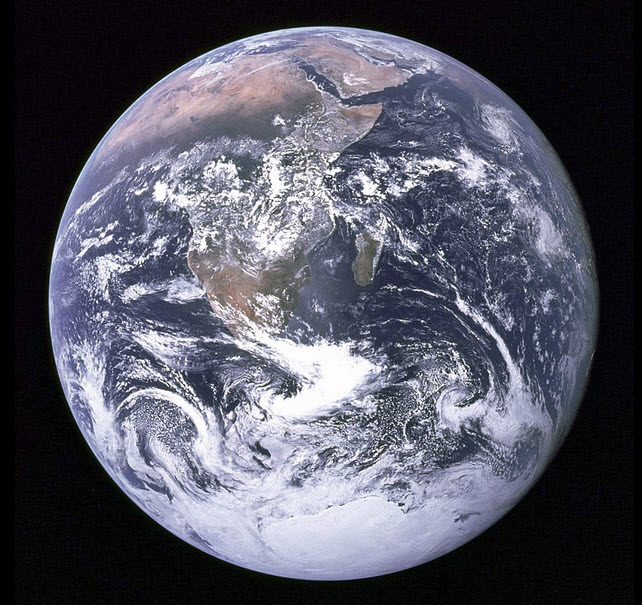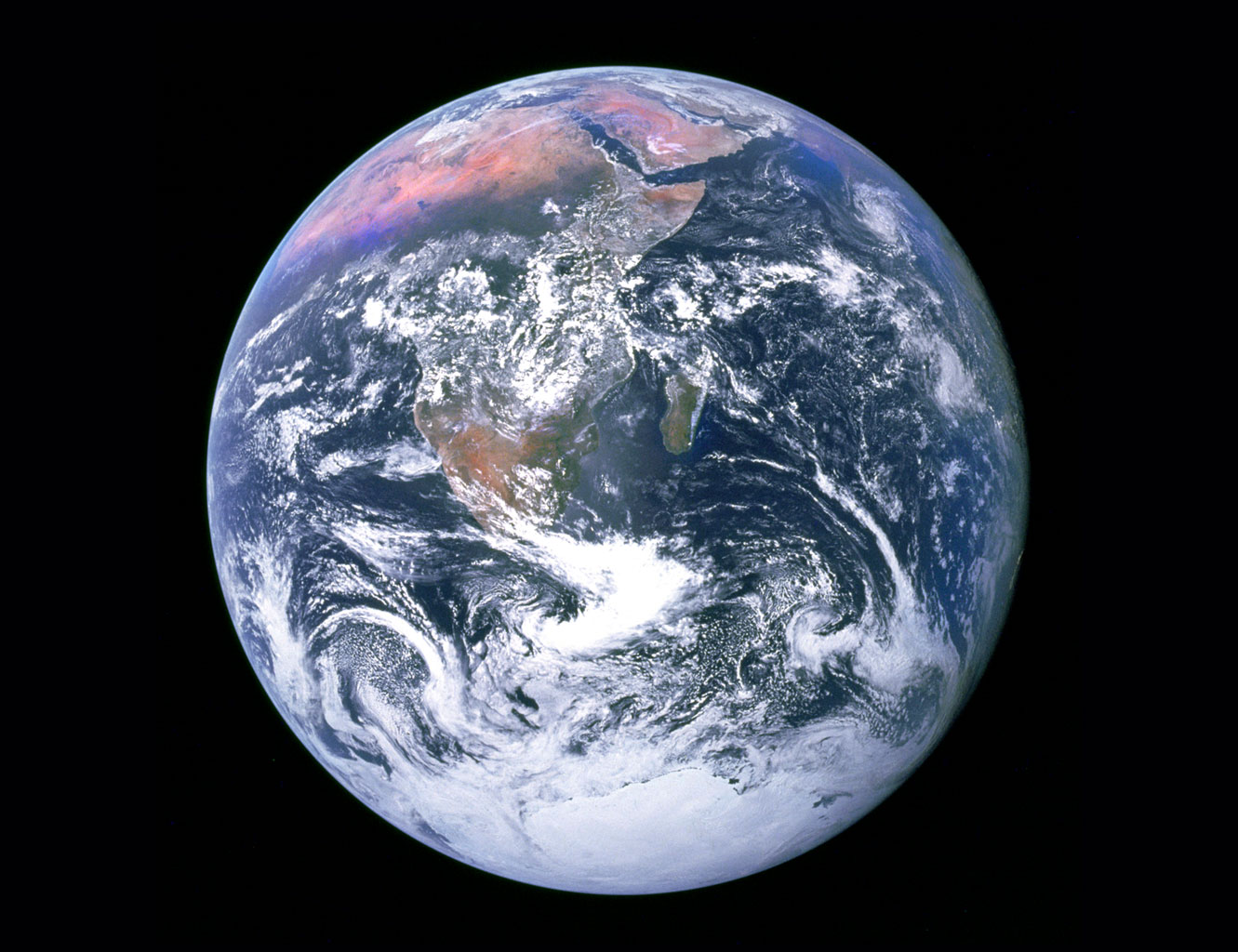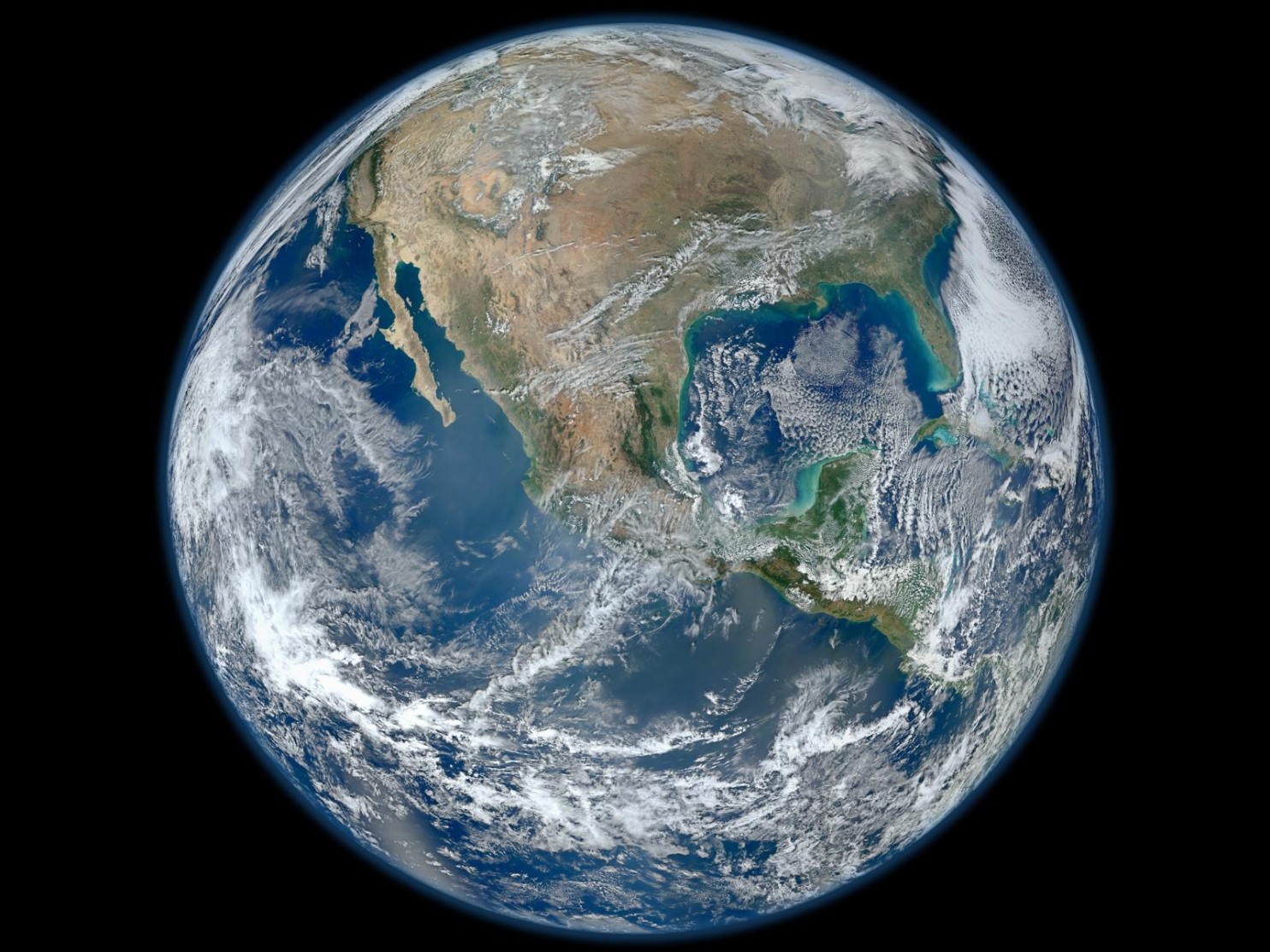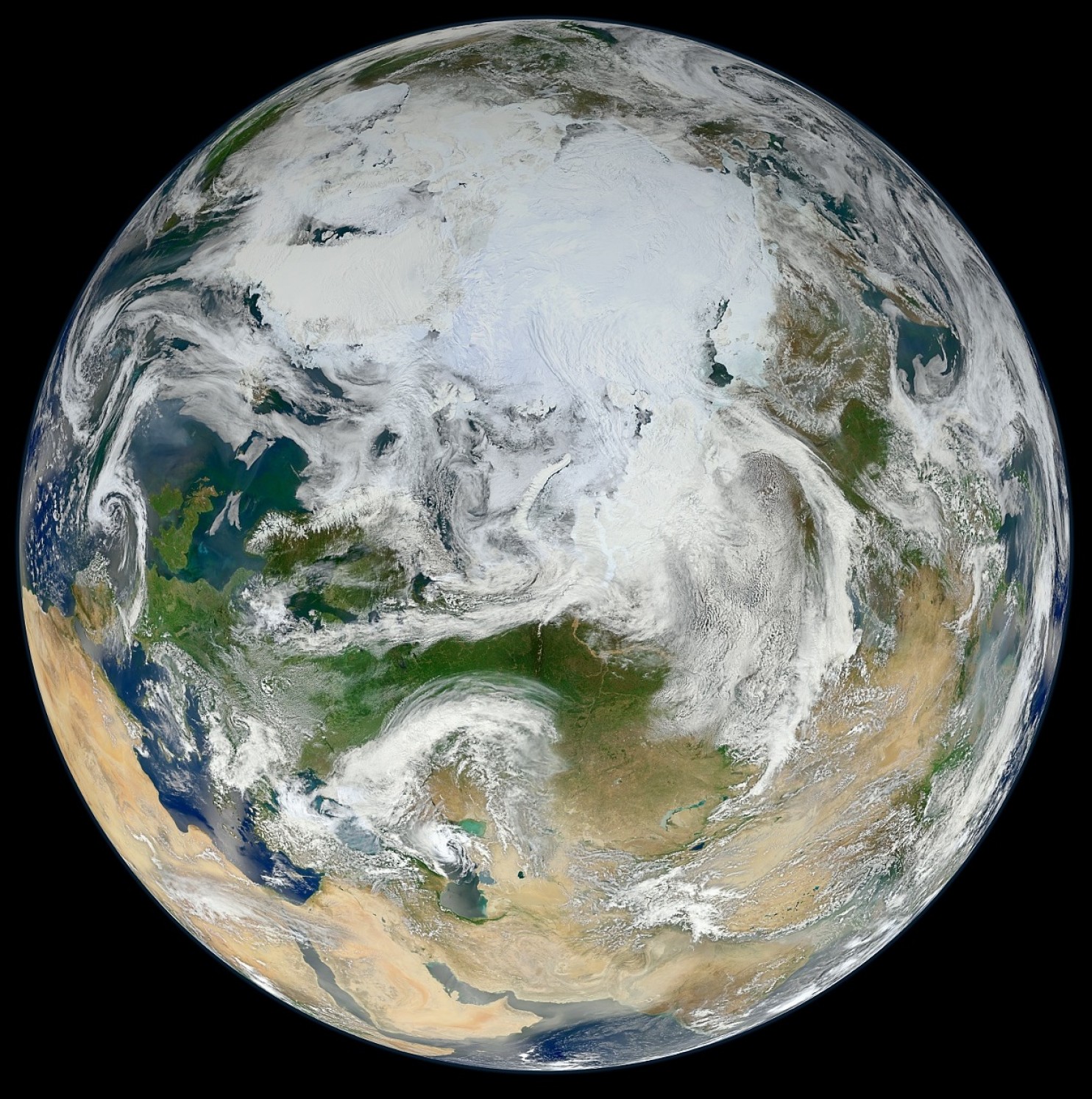Whole Earth: Difference between revisions
Siterunner (talk | contribs) No edit summary |
Siterunner (talk | contribs) No edit summary |
||
| (22 intermediate revisions by the same user not shown) | |||
| Line 1: | Line 1: | ||
[http://spaceflight.nasa.gov/gallery/images/apollo/apollo17/html/as17-148-22727.html '''NASA Image AS17-148-22727'''] | [http://spaceflight.nasa.gov/gallery/images/apollo/apollo17/html/as17-148-22727.html '''NASA Image AS17-148-22727'''] | ||
[http://www.theatlantic.com/technology/archive/2011/04/the-blue-marble-shot-our-first-complete-photograph-of-earth/237167/ Earth Image AS17-148-22727, the first photograph taken of the Whole Planet Earth.] | |||
The only image to date ever 'snapped' by a live human from deep space. | |||
[[File:Blue Marble photo - Apollo 17.jpg]] | [[File:Blue Marble photo - Apollo 17.jpg]] | ||
NASA named the 70mm Hasselblad image -- AS17-148-22727 | December 7, 1972 | ||
The first and only whole earth picture captured with a camera -- our "Blue Marble" | |||
• https://www.greenpolicy360.net/w/File:Whole_Earth_1972_Apollo_17.jpg | |||
NASA scientifically named the [https://airandspace.si.edu/collection-objects/camera-hasselblad-70mm-apollo-11 70mm Hasselblad camera] image -- AS17-148-22727 | |||
Later, on release to the public, the image became affectionately known as "Blue Marble" | |||
○ | |||
'''Feb | '''Feb 10, 2015''' -- Here in Florida, the terrestrial home of GreenPolicy360, another Deep Space mission is scheduled to launch, not with humans snapping images and pictures but a unique remote mission intended to monitor space weather and, due to its distance from Earth (orbiting at appoximately 1 million miles), the DSCOVR (Deep Space Climate Observatory) will be sending back daily images of the 'whole earth'... | ||
''"DSCOVR will be beaming back a steady stream of images of Planet Earth from space, a photo of Earth ever two hours, with the images expected to be available online the next days."'' | |||
''"They'll be posted on a website for the public to see," said Steven Clarke, director of NASA's Joint Agency Satellite Division. "I think it will be an inspiration for people to see the sunlit disk of the Earth."'' | |||
GreenPolicy360 is assisting in the release of the initial test images and, of course, they'll be numbered by NASA ;- | |||
"What will be the most impressive, after forty some years, will be the images of us, Planet Earth." -- #GreenPolicy360 | |||
''"To see and to experience #Earth360 daily is going to be a spectacular re-reminder of our place in the cosmos..."'' | |||
○ | |||
DSCOVR's earth facing camera is called EPIC -- [http://www.nesdis.noaa.gov/DSCOVR/pdf/DSCOVR%20-%20EPIC%20Instrument%20Info%20Sheet.pdf The Earth Polychromatic Imaging Camera (EPIC)] is an imager that provides global spectral images of the entire sunlit face of Earth, as viewed from an orbit around Lagrangian point 1 (L1) — the neutral gravity point between Earth and the sun. | |||
EPIC is able to view the entire sunlit Earth from sunrise to sunset at an almost constant scattering angle between 165–178°. This scattering angle has minimal overlap with other satellites’ scattering angles. | EPIC is able to view the entire sunlit Earth from sunrise to sunset at an almost constant scattering angle between 165–178°. This scattering angle has minimal overlap with other satellites’ scattering angles. | ||
| Line 22: | Line 49: | ||
EPIC’s observations from the L1 position will provide a unique angular perspective and can be combined with other measurements to obtain particle shape, phase selection, optical depth, 3-D effects and stereo heights. | EPIC’s observations from the L1 position will provide a unique angular perspective and can be combined with other measurements to obtain particle shape, phase selection, optical depth, 3-D effects and stereo heights. | ||
Benefits | |||
'''Benefits''' | |||
Imagery from EPIC will be used in science applications to measure ozone amounts, aerosol amounts, cloud height and phase, vegetation properties, hotspot land properties (a view of the land from angles where shadows are a minimum) and UV radiation estimates at Earth's surface. | Imagery from EPIC will be used in science applications to measure ozone amounts, aerosol amounts, cloud height and phase, vegetation properties, hotspot land properties (a view of the land from angles where shadows are a minimum) and UV radiation estimates at Earth's surface. | ||
Expected data products include: total ozone column, aerosol index, aerosol optical thickness, aerosol height, cloud fraction, cloud | Expected data products include: total ozone column, aerosol index, aerosol optical thickness, aerosol height, cloud fraction, cloud | ||
height, surface albedo, vegetation index, Leaf Area Index and RGB | height, surface albedo, vegetation index, Leaf Area Index and RGB colored image of the Earth’s sunlit surface. | ||
colored image of the Earth’s sunlit surface. | |||
These data products are of interest to climate science, as well as hydrology, biogeochemistry and ecology. | These data products are of interest to climate science, as well as hydrology, biogeochemistry and ecology. | ||
Another instrument, a sensor system called '''PlasMag''' will "keep an eye on solar weather and give the Earth updates whenever a storm on the Sun threatened to fry broad swaths of the electrical grid. That's a high-risk, low-probability event that has never happened at the feared scale. Fortunately. Yet." | |||
A third instrument, '''NISTAR''', will help calculate the Earth’s energy “budget,” the measurement perhaps most critical to understanding global warming: "Is more heat coming in than is going out?" The data will provide insight into the Earth’s "energy balance." | |||
[[File:Whole Earth 1972 Apollo 17.jpg]] | [[File:Whole Earth 1972 Apollo 17.jpg]] | ||
| Line 41: | Line 74: | ||
[[File: | [[File:North Pole.jpg]] | ||
[[Category:Earth360]] | |||
[[Category:EarthPOV]] | |||
[[Category:Earth Imaging]] | |||
[[Category:Earth Observations]] | |||
[[Category:Eco-ethics]] | |||
[[Category:Environmental Protection]] | |||
[[Category:Green Values]] | |||
[[Category:Green Politics]] | |||
[[Category:Nature]] | |||
[[Category:Planet Citizen]] | |||
[[Category:Planet Citizens]] | |||
[[Category:Planet Citizens, Planet Scientists]] | |||
[[Category:Whole Earth]] | |||
[[Category:Youth]] | |||
Latest revision as of 16:13, 25 March 2023
Earth Image AS17-148-22727, the first photograph taken of the Whole Planet Earth.
The only image to date ever 'snapped' by a live human from deep space.
December 7, 1972
The first and only whole earth picture captured with a camera -- our "Blue Marble"
• https://www.greenpolicy360.net/w/File:Whole_Earth_1972_Apollo_17.jpg
NASA scientifically named the 70mm Hasselblad camera image -- AS17-148-22727
Later, on release to the public, the image became affectionately known as "Blue Marble"
○
Feb 10, 2015 -- Here in Florida, the terrestrial home of GreenPolicy360, another Deep Space mission is scheduled to launch, not with humans snapping images and pictures but a unique remote mission intended to monitor space weather and, due to its distance from Earth (orbiting at appoximately 1 million miles), the DSCOVR (Deep Space Climate Observatory) will be sending back daily images of the 'whole earth'...
"DSCOVR will be beaming back a steady stream of images of Planet Earth from space, a photo of Earth ever two hours, with the images expected to be available online the next days."
"They'll be posted on a website for the public to see," said Steven Clarke, director of NASA's Joint Agency Satellite Division. "I think it will be an inspiration for people to see the sunlit disk of the Earth."
GreenPolicy360 is assisting in the release of the initial test images and, of course, they'll be numbered by NASA ;-
"What will be the most impressive, after forty some years, will be the images of us, Planet Earth." -- #GreenPolicy360
"To see and to experience #Earth360 daily is going to be a spectacular re-reminder of our place in the cosmos..."
○
DSCOVR's earth facing camera is called EPIC -- The Earth Polychromatic Imaging Camera (EPIC) is an imager that provides global spectral images of the entire sunlit face of Earth, as viewed from an orbit around Lagrangian point 1 (L1) — the neutral gravity point between Earth and the sun.
EPIC is able to view the entire sunlit Earth from sunrise to sunset at an almost constant scattering angle between 165–178°. This scattering angle has minimal overlap with other satellites’ scattering angles.
EPIC’s observations from the L1 position will provide a unique angular perspective and can be combined with other measurements to obtain particle shape, phase selection, optical depth, 3-D effects and stereo heights.
Benefits
Imagery from EPIC will be used in science applications to measure ozone amounts, aerosol amounts, cloud height and phase, vegetation properties, hotspot land properties (a view of the land from angles where shadows are a minimum) and UV radiation estimates at Earth's surface.
Expected data products include: total ozone column, aerosol index, aerosol optical thickness, aerosol height, cloud fraction, cloud height, surface albedo, vegetation index, Leaf Area Index and RGB colored image of the Earth’s sunlit surface.
These data products are of interest to climate science, as well as hydrology, biogeochemistry and ecology.
Another instrument, a sensor system called PlasMag will "keep an eye on solar weather and give the Earth updates whenever a storm on the Sun threatened to fry broad swaths of the electrical grid. That's a high-risk, low-probability event that has never happened at the feared scale. Fortunately. Yet."
A third instrument, NISTAR, will help calculate the Earth’s energy “budget,” the measurement perhaps most critical to understanding global warming: "Is more heat coming in than is going out?" The data will provide insight into the Earth’s "energy balance."



